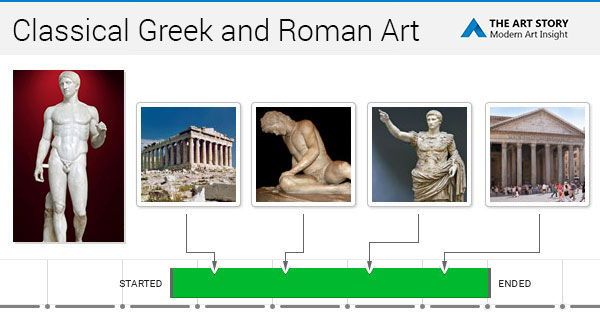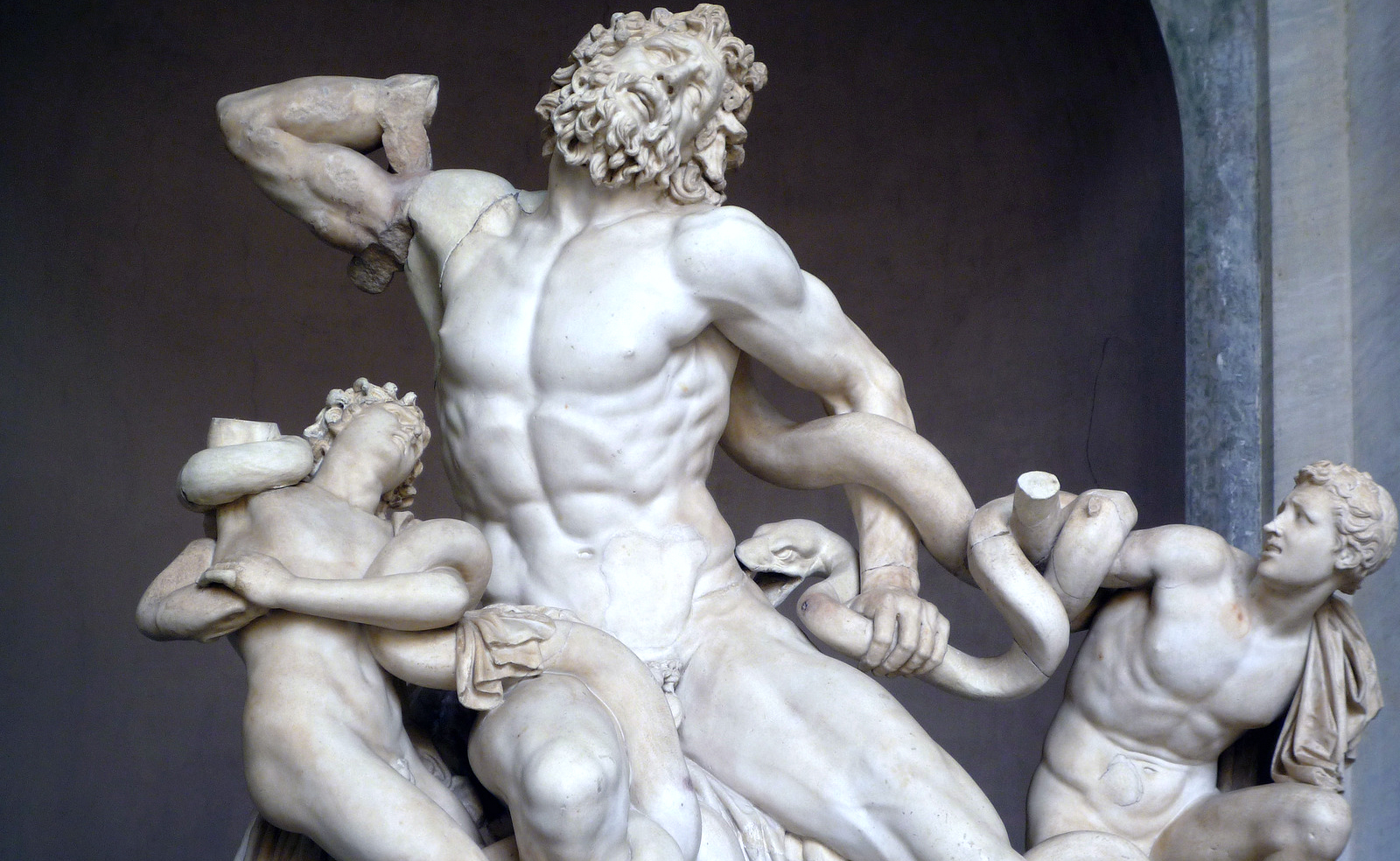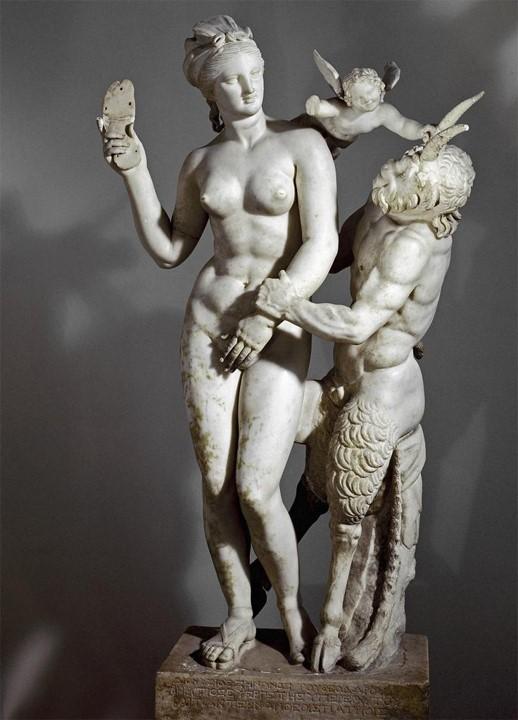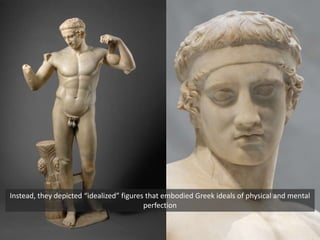For Hegel Romantic Christian art was the high point of the history of art a history which he believed complete and closed. Art of Ancient Greeces Classical Period.
The classical art form originated well ahead of the Hellenistic period.

. Prominent 1st century BC and 1st century AD Romans such as Cicero and Pliny the Elder greatly admired the innovative work of classical Greek sculpture artists such as Polykleitos. The sculptures were generally polychrome except for works made in bronze. Classical Greek sculptors were more imaginative because the Enlightenment released them from the dogma of the pharoahs.
The sculpture of the Italian Renaissance comprises the approximate period between the late fourteenth and the early sixteenth century when Italian sculpture expressed a reaction against the aesthetic principles of Gothic and assimilating the influence of classical antiquity art humanism and rationalism developed a style that merged naturalistic and other idealistic elements into. The Parthenon Marbles created by Phidias are perhaps the most famous examples of this style of Classical Greek sculpture. Portraying the dramatic features that are filled with happiness anger agony and humor.
The High Classical Greek art was more idealistic and it showed how the Greeks wanted to be portrayed and the Hellenisic art is much more realistic. O Introduce quoted or paraphrased information with signal phrases and include a parenthetical citation with page or paragraph number. Greek sculpture influenced the Romans from the 2nd century BC.
Absolutely both in terms of composition and also of applique. What was a fundamental difference between Greek classical sculpture and Greek Hellenistic sculpture. Classical Greek sculpture is both naturalistic and idealistic.
These relief sculptures are known for their dynamic movement and realism and decorated the temple chambers interior walls. Classical sculpture was both naturalistic and idealistic Government assembly halls The first Christian churches were patterned after basilicas used by he Romans as. Whether deliberately applied.
Classical Roman art differed from classical Greek art because Roman art focused on realism while Greek art focused on idealism. The Greeks and Romans both represented gods and rulers in the form of statues a combination of religious and political influence. Poses seemed more naturalistic as shown by the Polykleitos of Diadumenos sculpture.
Classical Art Art that was both Naturalistic and idealistic. A similar conflation can be found in the medium of classical sculpture which is both naturalistic and idealistic. An example of this is the bust of Pericles by Kresilas.
This sculpture and other reliefs of this time have influenced later artists like Auguste Rodin. Symbolic art for example was found in ancient Egypt. During the classical period Greek sculptures did what no one had done before by worshiping the human body through bronze and The sculptures were both human-size and human-like.
The scientific skill of Greek sculptors in showing the human form in distinct poses was improved. The only materials available to the Egyptian sculptors were stones that had a very. Ancient Greek sculpture represents a development from idealism to naturalism.
Funerary sculpture began depicting real people instead of idealized types with emotional expression while at the same time bronze. The Romans took many elements from Greek art but brought a more naturalistic and ostentatious style. The classical period characterized modifications in both the function and the style of the sculpture.
On the other hand much freedom could be seen in the Hellenistic art forms. The Greeks idealized the human form because much of their art was a. The origin of sculpture in Greek and Roman art can almost be divided into distinct categories- classical and idealistic vs naturalistic and emotional sculpture work.
Beautiful natural looking images of men and idealized images of Gods. In the Classical period this conflict reached an apotheosis when the two forces were balanced against each other. However the Romans did not produce much sculpture based on the classical Greek model.
In the fallen warrior greece and the dying gaul roman copy both clearly represent a. Create an account to start this course today. Ancient Greek sculpture of the Classical period depicts beauty through the balance of naturalism and idealism.
Defined by a careful observation of nature a new concern for the mechanics of the body and the pursuit of ideal forms Classical Greek sculpture represents a radical departure from the compact forms and upright poses of Archaic male nudes. Classical Period 480-323 BCE Art produced during this period was considered the finest of the finest. Where Greek statues and sculptures depict calm ideal figures in the nude Roman sculpture is highly decorative and more concerned with realistic depictions of individualsThe Romans took many elements from Greek art but brought a more naturalistic.
Look up Painted Greek Sculpture just to start and know that then as now every surface has a finish. Greek sculpture marked the height of Classical art and Romantic art grew with Christianity. 3 points QUESTION 25 1.
In Hegels analysis each style of art also had its paradigmatic art form. At the end of your analysis include a Works. The classic sculptures do not come with these emotions but were idealized or static.
Art imitated the art of greeks but used a more naturalistic approach. Roman artists typically made realistic portraits and sculptures. Indeed John Boardman describes the work of Polyclitus Fig 2 a sculptor who canonized the male athletic body in classical period art as ideally realistic Boardman 157.
O It is your task to write an essay that explains how this sculpture demonstrates the Humanistic Rationalistic and Idealistic values of the Classical Greek era. Polykleitos Spear Bearer Classical art that emphasized rational simplicity order and restrained emotion. The Hellenistic art form is seen to be depicting more emotions.
Classical Greek figures appear more relaxed than the rigid formal Egyptian and early Greek sculptural poses because _____. Classical greek sculptures became increasingly naturalistic and began to show the body as alive and capable of movement while maintaining an interest in portraying the ideal human anatomy Greek Architecture.

Classical Art And Architecture History Theartstory

Greek Art Art History Teaching Resources

Introduction To Ancient Greek Art Article Khan Academy

The Story Of Art Symbolism Idealism And Realism Carolyn Anderson Blog

Art History Midterm Flashcards Chegg Com

Form And Reality The Classical Greek Balance Of The Ideal And The Natural Disrecognized Space

Classical Greek Sculpture Is Both Naturalistic And Idealistic True Or False Study Com

Classical Sculpture Was Both Naturalistic And Idealistic Fashiondesignstudioofficestyle
0 comments
Post a Comment